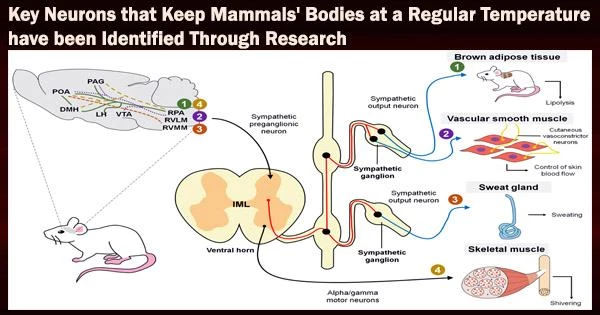According to studies from Nagoya University in Japan, the preoptic area of the brain has a group of neurons known as EP3 neurons that are essential for controlling body temperature in animals.
The discovery could lead to the creation of equipment that modifies body temperature artificially in order to cure conditions including obesity, hypothermia, and heat stroke. The new study was published in the journal Science Advances.
Humans and many other mammals maintain their body temperature at a level of about 37°C (98.6°F), which is ideal for all regulatory processes. Functions are hampered when the body temperature noticeably exceeds the normal range, which can result in heat stroke, hypothermia, and, in the worst case scenario, death.
However, if body temperature can be artificially brought into the normal range, these problems might be addressed. The preoptic area of the hypothalamus, which regulates the body’s essential processes, is where the brain’s temperature control center is located.
For example, when the preoptic area receives signals from a mediator called prostaglandin E (PGE2) that is produced in response to infections, this area releases a command to raise body temperature to fight against viruses, bacteria, and other disease-causing organisms.
The precise neurons in the preoptic region that send signals to raise or lower body temperature are still unknown. To identify such neurons, Professor Kazuhiro Nakamura, Lecturer Yoshiko Nakamura, and their colleagues at Nagoya University, in collaboration with Professor Hiroyuki Hioki at Juntendo University, conducted a study using rats. They focused on EP3 neurons in the preoptic area, which express EP3 receptors of PGE2, and investigated the function for regulating body temperature.
Probably, EP3 neurons in the preoptic area can precisely regulate the signal strength to fine-tune body temperature. For example, in a hot environment, signals are augmented to suppress sympathetic outputs, resulting in increased blood flows in the skin to facilitate the radiation of the body’s heat to prevent heat stroke. However, in a cold environment, signals are reduced to activate sympathetic outputs, which promote heat production in brown adipose tissue and other organs to prevent hypothermia. Furthermore, at the time of infection, PGE2 acts on EP3 neurons to suppress their activity, resulting in activation of sympathetic outputs to develop fever.
Professor Kazuhiro Nakamura
First, Professor Nakamura and his team looked into how variations in ambient temperature affect the activity of EP3 neurons in the preoptic area. A comfortable environmental temperature for rats is about 28°C. For two hours, the researchers exposed the rats to cold (4°C), room (24°C) and hot (36°C) temperatures.
The findings demonstrated that whereas exposure to 4°C and 24°C did not activate EP3 neurons, exposure to 36°C did. In order to determine where the signals from EP3 neurons are transmitted, the scientists then looked at the nerve fibers of EP3 neurons in the preoptic region.
The study found that nerve fibers are dispersed throughout the brain, especially in the dorsomedial hypothalamus (DMH), which is responsible for sympathetic nervous system activation. Gamma-aminobutyric acid (GABA), a potent inhibitor of neuronal excitation, is the molecule that EP3 neurons use for the signal transfer to DMH, according to their investigation.
Researchers experimentally altered EP3 neurons’ activity using a chemogenetic method to better understand the function of these neurons in temperature regulation. They discovered that raising body temperature resulted from suppressing the neurons’ activity while lowering it resulted from activating them.
Together, the results of this study demonstrated that EP3 neurons in the preoptic area are essential for controlling body temperature because they release GABA to communicate inhibitory signals to DMH neurons, which in turn regulate sympathetic responses.
“Probably, EP3 neurons in the preoptic area can precisely regulate the signal strength to fine-tune body temperature,” said Prof. Nakamura, the lead author of the study.
“For example, in a hot environment, signals are augmented to suppress sympathetic outputs, resulting in increased blood flows in the skin to facilitate the radiation of the body’s heat to prevent heat stroke. However, in a cold environment, signals are reduced to activate sympathetic outputs, which promote heat production in brown adipose tissue and other organs to prevent hypothermia. Furthermore, at the time of infection, PGE2 acts on EP3 neurons to suppress their activity, resulting in activation of sympathetic outputs to develop fever.”
The results of this study may lead to the creation of a technology that artificially modifies body temperature and has potential applications in numerous medical specialties. Interestingly, this technology may help treat obesity by maintaining a slightly elevated body temperature that encourages fat burning.
“On top of that, this technology could lead to new strategies for survival of people in hotter global environments, which are becoming a serious worldwide problem,” said Prof. Nakamura.
“Prostaglandin EP3 receptor-expressing preoptic neurons bidirectionally control body temperature via tonic GABAergic signaling” is published in Science Advances on December 23, 2022.
















